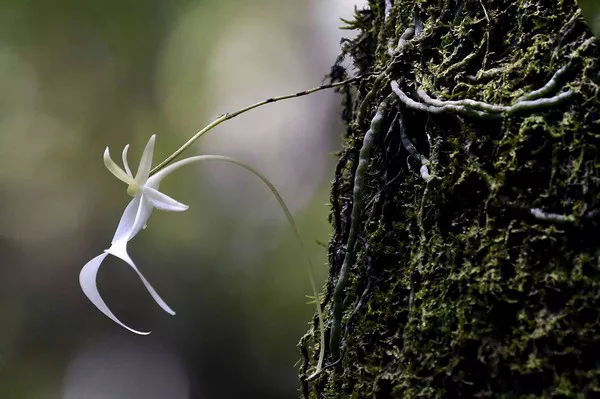In the vast realm of botanical wonders, some flowers stand out as rare and extraordinary, captivating the imagination with their unique beauty and scarcity. In this exploration, we delve into the enchanting world of the 15 rarest flowers, each a testament to the intricacies of nature’s design. From the remote corners of the rainforests to the high-altitude meadows, these floral gems showcase the diversity and resilience of plant life.
The 15 Rarest Flowers in the World
1. Ghost Orchid (Dendrophylax lindenii):
The Ghost Orchid, native to Florida and Cuba, is an elusive and rare flower that earned its name due to its ghostly appearance. With a delicate white bloom and an uncanny resemblance to a spectral figure, this orchid is known for its unique pollination mechanism involving nocturnal moths. Its scarcity makes it a prized find for orchid enthusiasts and researchers alike.
2. Middlemist’s Red (Middlemist camellia):
Originating from China, Middlemist’s Red is one of the rarest flowers in the world. With only two known specimens in existence, one in New Zealand and the other in the United Kingdom, this camellia variety boasts vibrant red blooms. Its scarcity is attributed to habitat loss and the challenges of propagation, making it a living relic from a bygone era.
3. Corpse Flower (Amorphophallus titanum):
Known for its enormous size and pungent odor reminiscent of a rotting corpse, the Corpse Flower is a botanical marvel found in the rainforests of Sumatra. Despite its intimidating name, this rare flower attracts crowds when it blooms, as its inflorescence can reach heights of up to 10 feet. The sporadic blooming and the need for specific environmental conditions contribute to its rarity.
4. Jade Vine (Strongylodon macrobotrys):
Hailing from the Philippines, the Jade Vine is renowned for its stunning turquoise-colored flowers that drape in cascading clusters. As a rare member of the pea and bean family, its unique color is a result of a combination of pigments. Deforestation and habitat loss threaten its existence, underscoring the urgency of conservation efforts to preserve this rare botanical treasure.
5. Chocolate Cosmos (Cosmos atrosanguineus):
Endemic to Mexico, the Chocolate Cosmos stands out not only for its deep maroon blooms but also for its distinct chocolate fragrance. Thought to be extinct in the wild, this flower has been successfully reintroduced through cultivation. Its scarcity and captivating aroma make it a sought-after addition to botanical gardens worldwide.
6. Youtan Poluo:
Known as the world’s smallest flower, Youtan Poluo is native to the Hengduan Mountains in Tibet. Measuring a mere 1mm in diameter, the delicate white blossoms appear only once in three millennia, according to Buddhist folklore. While its existence is debated among scientists, the legend and rarity surrounding Youtan Poluo contribute to its mystique.
7. Kadupul Flower (Epiphyllum oxypetalum):
Endemic to Sri Lanka, the Kadupul Flower is renowned for its ethereal beauty and captivating fragrance. What makes this flower exceptionally rare is its nocturnal blooming, and each blossom lasts only for a few hours. Considered priceless in Sri Lankan culture, attempts to cultivate it outside its native habitat have proven challenging, adding to its allure.
8. Gibraltar Campion (Silene tomentosa):
Endemic to the limestone cliffs of Gibraltar, the Gibraltar Campion is one of the rarest flowering plants globally, with only a handful of individuals remaining in the wild. Its precarious existence is attributed to habitat destruction, and conservation efforts are underway to ensure the survival of this resilient species. The small, white flowers stand as a symbol of tenacity in the face of adversity.
9. Attenborough’s Pitcher Plant (Nepenthes attenboroughii):
Discovered in the remote mountains of the Philippines, Attenborough’s Pitcher Plant is a recent addition to the list of the world’s rarest flowers. Named in honor of Sir David Attenborough, this carnivorous plant lures insects into its pitcher-shaped traps. Its scarcity is compounded by threats such as habitat destruction and poaching, highlighting the need for conservation measures.
10. Yellow and Purple Lady Slippers (Cypripedium calceolus):
The Yellow and Purple Lady Slippers, also known as the Lady’s Slipper Orchids, are native to Europe and Asia. Characterized by their slipper-shaped pouches, these orchids have become increasingly rare due to habitat loss and over-collection. Efforts to protect their natural habitats and promote conservation are essential to ensure the continued existence of these delicate and captivating flowers.
11. Parrot’s Beak (Impatiens psittacina):
Native to Myanmar, Parrot’s Beak is a rare and peculiar flower that resembles a parrot in flight. The vibrant hues of red, green, and yellow contribute to its avian mimicry. Threatened by habitat loss and overharvesting, conservation efforts aim to safeguard this unique species and its remarkable floral mimicry.
12. Franklin’s Lady’s Slipper (Cypripedium × andrewsii):
Endemic to the United States and Canada, Franklin’s Lady’s Slipper is a rare orchid hybrid. With delicate pink and white blooms, it faces threats from habitat destruction and illegal collection. Conservation initiatives aim to protect its native habitats and ensure the survival of this North American botanical treasure.
13. Rothschild’s Slipper Orchid (Paphiopedilum rothschildianum):
Named after the Rothschild family, this slipper orchid is native to Mount Kinabalu in Borneo. With a striking color palette and intricate patterns, this orchid is a symbol of rarity and elegance. Conservation efforts focus on preserving its mountainous habitat, safeguarding this regal orchid for generations to come.
14. Himalayan Blue Poppy (Meconopsis betonicifolia):
Native to the Himalayas, the Himalayan Blue Poppy is celebrated for its stunning blue blossoms, a rarity in the floral world. The challenges of cultivation and its specific habitat requirements contribute to its scarcity. Conservation initiatives aim to protect the delicate balance of the Himalayan ecosystem, ensuring the continued existence of this botanical marvel.
15. Queen of the Andes (Puya raimondii):
Endemic to the high-altitude regions of the Andes in South America, the Queen of the Andes is a massive flowering plant with a remarkable life cycle. Known for its towering inflorescence, this rare flower blooms only once in its lifetime, producing thousands of flowers. Habitat destruction and climate change pose significant threats to its survival, emphasizing the importance of conservation efforts in preserving this botanical giant.
See also: Top 10 Dangerous (& Sometimes Deadly!) Trees
Conclusion
In the delicate dance of pollination, the world’s rarest flowers emerge as jewels in the vast tapestry of nature. From the mysterious Ghost Orchid to the regal Queen of the Andes, each bloom tells a story of resilience, adaptation, and the intricate interplay of life on Earth. As we marvel at these botanical wonders, it becomes clear that the preservation of their habitats is essential to ensure that future generations can continue to witness the rare beauty that nature so graciously bestows upon us.
You Might Be Interested In:










![10 Most Richest Cities in the United States [Revealed!]](https://www.validdownloads.com/wp-content/uploads/2023/12/Manjula-Pothos.webp)















